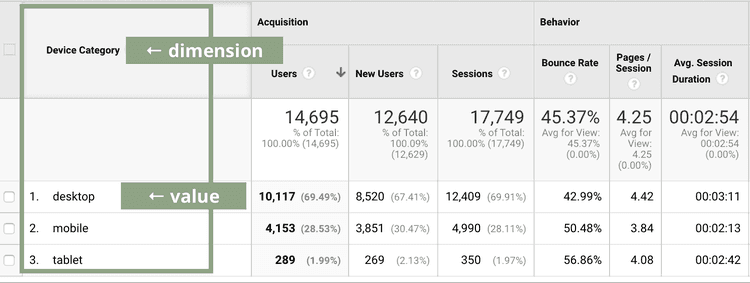Navigating the Midst of Additional Dimension in Google Analytics: A Detailed Exploration on Its Capability
Secondary measurements, though apparently straightforward at initial look, harbor a wide range of untapped possible waiting to be used. As we embark on this trip to check out the nuanced performance of additional dimensions, we will certainly uncover exactly how this attribute can brighten patterns, reveal relationships, and inevitably pave the means for notified decision-making in the digital landscape (what is a “secondary dimension” in google analytics?).
Understanding Additional Measurements in Google Analytics

Recognizing exactly how second measurements job is important for leveraging the full power of Google Analytics. By integrating main metrics with second measurements, you can get useful understandings that drive notified decision-making and optimization approaches.
Leveraging Second Measurements for Data Evaluation
Structure upon the fundamental understanding of how secondary dimensions boost information evaluation in Google Analytics, the application of these added layers of information becomes extremely important in extracting beneficial insights for informed decision-making and optimization approaches. By leveraging additional dimensions, analysts can dig much deeper into the performance metrics by adding even more context to the main dimensions, thus discovering concealed patterns and relationships that may not appear initially glance. This much deeper degree of analysis enables companies to better understand user actions, determine fads, and identify areas for renovation.
Additionally, additional measurements provide an even more extensive view of the information, enabling division based on various specifications such as demographics, devices, web traffic resources, and much more. This segmentation assists in a more granular analysis, enabling businesses to tailor their approaches and projects to particular target market sectors for improved targeting and personalization. In significance, the critical use additional measurements empowers organizations to make data-driven choices that drive growth and success in the digital landscape.
Advanced Techniques for Additional Dimension Implementation
Checking out intricate approaches to harness the full capacity of additional dimensions in Google Analytics elevates the depth and sophistication of data analysis for strategic decision-making. One sophisticated technique for applying additional measurements is making use of custom-made dimensions. By specifying personalized measurements, customers can section information even more to get even more certain insights right into individual habits, such as tracking interactions with certain aspects on a web page or keeping an eye on the efficiency of a particular marketing project. One more advanced strategy is the utilization of regex (normal expressions) within second measurements. Regex enables more effective and versatile pattern matching, making it possible for users to produce intricate filters for information analysis. Furthermore, incorporating additional measurements with advanced sectors can supply much more granular insights by using multiple layers of segmentation to the data. This method permits a deeper understanding of individual habits based upon different standards all at once. Carrying out these sophisticated techniques for secondary dimensions in Google Analytics empowers customers to perform extra sophisticated evaluation and make data-driven decisions with accuracy.
Interpreting Insights With Secondary Dimensions

When translating insights via secondary dimensions, it is necessary to take into consideration the context of the data and exactly how different dimensions interact with each various other. Understanding which specific web traffic resources lead to higher conversion rates or identifying which devices customers prefer for making purchases can provide workable insights for enhancing advertising and marketing projects and boosting general internet site efficiency. By very carefully taking a look at the data with second measurements in mind, companies can make informed choices that drive purposeful results and improve their digital visibility.
Enhancing Efficiency With Secondary Measurements

One essential method to Discover More Here enhance efficiency with additional dimensions is by segmenting data much more granularly. This permits you to separate specific variables that may be influencing your metrics and gain a much better understanding of what drives success or failing in your electronic initiatives. For instance, by combining secondary dimensions such as 'tool classification' and 'touchdown web page,' you can pinpoint which tool types are most reliable for specific landing pages, enabling you to customize your strategies as necessary.
In addition, using second dimensions can help you determine patterns, patterns, and connections that might not appear when evaluating data with primary measurements alone. This much deeper degree of analysis can lead to even more enlightened decision-making and eventually improve the total efficiency of your web site or electronic marketing campaigns.
Final Thought
To conclude, second measurements in Google Analytics play an important duty in improving data analysis and offering deeper insights into site efficiency. By utilizing advanced strategies and translating the information efficiently, services can optimize their strategies and boost general performance. Comprehending the functionality of secondary measurements is necessary for making informed choices and driving success in the electronic landscape.
By leveraging second dimensions, experts can dive deeper right into the performance metrics by adding more context to the key dimensions, therefore revealing concealed patterns and connections that might not be apparent at initial look. One sophisticated strategy for implementing second measurements is the usage of customized measurements.Having actually grasped innovative techniques like personalized dimensions and regex for additional measurement execution in Google these details Analytics, the following important step is interpreting the useful understandings obtained with these sophisticated data division methods. Analyzing understandings with additional dimensions involves analyzing the relationships between the second and key dimensions picked, uncovering patterns, patterns, and connections that may not be right away evident when looking at the data in its whole.When translating insights via second dimensions, it is necessary to consider the context of the data and how different measurements interact with each various other.